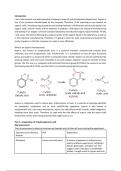Summary
Summary unit 4: Learning aim C ( Explore manufacturing techniques and testing methods for an organic solid)
- Course
- Institution
The assignment comprehensively covers testing methods and techniques crucial for analyzing organic liquids, including measurement of boiling points, infrared spectroscopy, and chromatography. It provides a thorough understanding of principles and applications in both lab and industry, earning a Dis...
[Show more]



